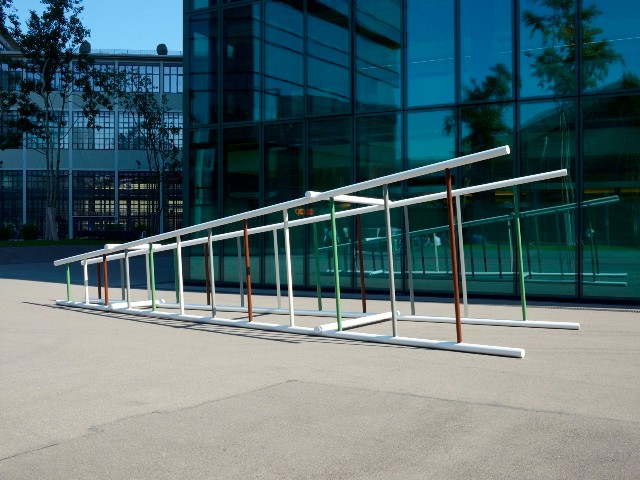Werner Feiersinger
Untitled, 2015

Im ehemaligen Industriegebiet Zürich-West steht das momentan höchste Gebäude der Schweiz: der Prime Tower. Für Werner Feiersinger (*1966, AT) ist der kühle, spröde Platz am Fusse des Towers der optimale Ort für seine Aussenraumskulptur. Eine komprimierte Umgebung hat er gesucht, einen reduzierten, urbanen Leerraum. Der Boden aus grauem Asphalt und die Fläche aus grünem Glas sind die optischen Gegebenheiten, auf die er sich bezieht.
In dieser verknappten Gewerbelandschaft hat der Künstler eine Leiter abgelegt. Ein alltägliches Objekt, glaubt man zunächst, das der Bautrupp vergass mitzunehmen. Mit seinen 9,7 m Länge und 3,3 m Breite ist es jedoch um die eine Idee zu gross, um tatsächlich zu sein, was es vorgibt. Und das haben Feiersingers Skulpturen so an sich. Was zunächst einem vertrauten Kanon unterworfen scheint, irritiert bei näherer Betrachtung; was ein erster Blick als festen Wert taxiert, wird unterwandert und entgleist ins Paradoxe.
Werner Feiersingers Kunstwerke lagern gleichermassen in den Regalen der Architektur, der Skulptur und der Gebrauchsobjekte. Ihre Programmatik verdankt sich Donald Judds Specific Objects (die Raum nicht dar-, sondern herstellen), dem Kanon von Minimal und Pop Art sowie einem fabelhaften Sinn für Form, der einhergeht mit einem besonderen Interesse an den Methoden von Slapstick und Vexierbildern. All das wird unterlegt mit einem Subtext, der sich gegen die Verwertungslogik des Kapitalismus wendet. Vielfältige Bezugssysteme kommen bei der Leiter ins Spiel: Mit seinem Riesenspielzeug erweist Feiersinger dem niederländischen Architekten Aldo van Eyck Referenz. Und auf einer Reise nach Indien, zu Le Corbusiers Planstadt Chandigarh, verliebte sich Feiersinger in die einfachen Leitern und Bambusgerüste, die dort verwendet werden. Letztendlich könnten auch die schrillen Leiter-Choreografien von Stan Laurel und Oliver Hardy Impuls für Feiersingers titelloses und dennoch sprechendes Werk gewesen sein.
Feiersinger misstraut kostbaren Oberflächen. Wenn er etwa noble Metalle wie Edelstahl verwendet, dann lässt er das Material unter mehreren Farbschichten komplett verschwinden. Die Leiter ist aus verzinkten Stahlrohren gefertigt und mit all den Grundierungsfarben gestrichen, die Feiersinger im Einsatz hat, um seine Skulpturen zu mattieren. «In meiner Arbeit geht es um das Zeichenhafte und um Konturen», sagt der Künstler, «ums Metaphorische und das Mehrdeutige der Objekte.» So bilden die Sprossen der abgelegten Leiter eine durchlässige Struktur und funktionieren wie eine Zeichnung im Raum. Brigitte Huck
Courtesy the artist und Galerie Martin Janda, Wien
Mit Unterstützung von: Bundeskanzleramt Österreich Kunst und Kultur, Land Tirol, Österreichisches Kulturforum Bern
English Version
In the former industrial area Zurich West, there stands what is currently Switzerland’s tallest building: Prime Tower. For Werner Feiersinger (b. 1966, Austria) the cool, standoffish plaza at the base of this tower is the optimal location for his outdoor sculpture. He had sought a compromised environment, a reduced urban empty space. The grey asphalt ground and the green glass surface are the visual givens that he deals with.
In this stripped-down commercial landscape, the artist has laid down a ladder. It initially appears to be an everyday object that builders forgot to take with them. However, measuring 9.7 m long and 3.3 m wide, it is slightly too large to really be what it purports to be. This represents an intrinsic quality of Feiersinger’s sculptures. What first appears to be subordinate to a familiar canon, irritates upon closer inspection; what is assessed as a fixed quantity at first glance, is then undermined and caused to slip into the paradoxical:
functionality, for example, but also materiality.
Werner Feiersinger’s artworks reside in the domains of architecture, sculpture and functional objects, all to an equal extent. Their objectives are a result of Donald Judd’s Specific Objects (making the space, rather than representing it), the canon of minimal art and pop art (including the associated penchant for irony), and a fabulous sense of form, which is accompanied by a particular interest in the methods of slapstick and visual puns. All of this is given an underlying subtext, which opposes capitalism’s logic of exploitation. In the case of this ladder, various reference systems come into play: With his giant toy, Feiersinger is making reference to the Dutch architect Aldo van Eyck. Furthermore, on a trip to India’s Chandigarh, a city planned by Le Corbusier, Feiersinger fell in love with the simple ladders and bamboo scaffolding that are used there. Finally, the extravagant ladder choreographies of Stan Laurel and Oliver Hardy may also have given momentum to Feiersinger’s work, which is untitled, but speaks nevertheless.
Feiersinger distrusts valuable surfaces. If he uses highgrade metals, such as stainless steel for instance, he causes the material to disappear completely under several coats of paint. This ladder is made of galvanised steel pipes and coated with all the primer paints that Feiersinger uses to give his sculptures a matt finish. “My work is about the symbolic and about contours,” says the artist, “about the metaphorical and the ambiguous aspects of objects.” The rungs of the laid-down ladder, for example, form a permeable structure and function like a drawing in the space. Brigitte Huck
Courtesy of the artist and Galerie Martin Janda, Vienna
Supported by Bundeskanzleramt Österreich Kunst und Kultur, Land Tirol, Österreichisches Kulturforum Bern